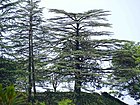Note: This is a project under development. The articles on this wiki are just being initiated and broadly incomplete. You can Help creating new pages.
Difference between revisions of "Cedrus deodara - Devadaru"
(→References) |
(→List of Ayurvedic medicine in which the herb is used) |
||
| Line 45: | Line 45: | ||
==List of Ayurvedic medicine in which the herb is used== | ==List of Ayurvedic medicine in which the herb is used== | ||
| − | + | * [[Devdarvadi kashaya]] | |
| + | * [[Chandraprabha vati]] | ||
| + | * [[Pushkarmulasava]] | ||
| + | * [[Maharasnadi kashaya]] | ||
| + | <ref name="Ayurvedic properties"/> | ||
==Where to get the saplings== | ==Where to get the saplings== | ||
Revision as of 17:10, 4 June 2019
Devadaru, is a very elegant ornamental tree, commonly found on the slopes of Western Himalayas. It is a large evergreen coniferous tree reaching 40-50 m tall, exceptionally 60 m, with a trunk up to 3 m diameter. It has a conic crown with horizontal branches and drooping branchlets.
Contents
- 1 Uses
- 2 Parts Used
- 3 Chemical Composition
- 4 Common names
- 5 Properties
- 6 Habit
- 7 Identification
- 8 List of Ayurvedic medicine in which the herb is used
- 9 Where to get the saplings
- 10 Mode of Propagation
- 11 How to plant/cultivate
- 12 Commonly seen growing in areas
- 13 Photo Gallery
- 14 References
- 15 External Links
Uses
BLoating, Hiccups, Urinary tract disorders, diabetes, Inflammation [1]
Parts Used
Bark, Heartwood, Resin, Oil, Leaves
Chemical Composition
Common names
| Language | Common name |
|---|---|
| Kannada | bhadradaaru, daevadaaru |
| Hindi | devdar |
| Malayalam | devataram |
| Tamil | devadaram, devadaru, devadharam |
| Telugu | |
| Marathi | NA |
| Gujarathi | NA |
| Punjabi | NA |
| Kashmiri | NA |
| Sanskrit | amarataru, badradaru, bhadrakasta, suradruma, indravrksa |
| English | Devdar, Himalayan Cedar |
Properties
Reference: Dravya - Substance, Rasa - Taste, Guna - Qualities, Veerya - Potency, Vipaka - Post-digesion effect, Karma - Pharmacological activity, Prabhava - Therepeutics.
Dravya
Rasa
Tikta (Bitter), Katu (Pungent), Kashaya (Astringent)
Guna
Laghu (Light), Rooksha (Dry)
Veerya
Ushna (Hot)
Vipaka
Kapha, Vata
Prabhava
Habit
Identification
Leaf
| Kind | Shape | Feature |
|---|---|---|
| Needles | Needles blue-green, about 30 in a cluster, 3-5 cm long, acuminate |
Flower
| Type | Size | Color and composition | Stamen | More information |
|---|---|---|---|---|
| Unisexual | Male and female cones | Flowers appear in September and October. Cones solitary or in pairs. ovate or barrel-shaped. 7-10 cm long, 5-6 cm wide, rounded at the apex, bluish when young, reddish-brown when ripe; maturing from September to November |
Fruit
| Type | Size | Mass | Appearance | Seeds | More information |
|---|---|---|---|---|---|
| Cone | the seed is shed from scaly cones from September to December; seed scales 5-6 cm wide, usually glabrous on the upper side. Seed about 17 mm long, about 6 mm wide; wing large, light brown | {{{5}}} | {{{6}}} |
Other features
List of Ayurvedic medicine in which the herb is used
Where to get the saplings
Mode of Propagation
How to plant/cultivate
Seed - collect the cones in winter and keep in a warm room until they open. Sow immediately in a cold frame. One report says that a short cold stratification of one month improves germination rates. Keep the seed pot moist, but be careful because the young seedlings are very prone to damp off, keep them well ventilated. [5]
Commonly seen growing in areas
Photo Gallery
References
- ↑ https://easyayurveda.com/2014/12/18/devadaru-cedrus-deodara-uses-research-side-effects/"Uses"]
- ↑ "Vernacular names"
- ↑ "BOTANIC DESCRIPTION"
- ↑ Cite error: Invalid
<ref>tag; no text was provided for refs namedAyurvedic properties - ↑ "Cultivation details"
External Links
- Pages with reference errors
- Ayurvedic Herbs known to be helpful to treat BLoating
- Ayurvedic Herbs known to be helpful to treat Hiccups
- Ayurvedic Herbs known to be helpful to treat Urinary tract disorders
- Ayurvedic Herbs known to be helpful to treat diabetes
- Ayurvedic Herbs known to be helpful to treat Inflammation
- Herbs with Bark used in medicine
- Herbs with Heartwood used in medicine
- Herbs with Resin used in medicine
- Herbs with Oil used in medicine
- Herbs with Leaves used in medicine
- Herbs with common name in Kannada
- Herbs with common name in Hindi
- Herbs with common name in Malayalam
- Herbs with common name in Tamil
- Herbs with common name in Sanskrit
- Herbs with common name in English
- Habit - Tree
- Index of Plants which can be propagated by Seeds
- Herbs that are commonly seen in the region of Temperate area
- Herbs that are commonly seen in the region of Himalayas
- Herbs
- Himalayas
- Tree
- Ayurvedic herbs that don't have seed photos
- Pinaceae




